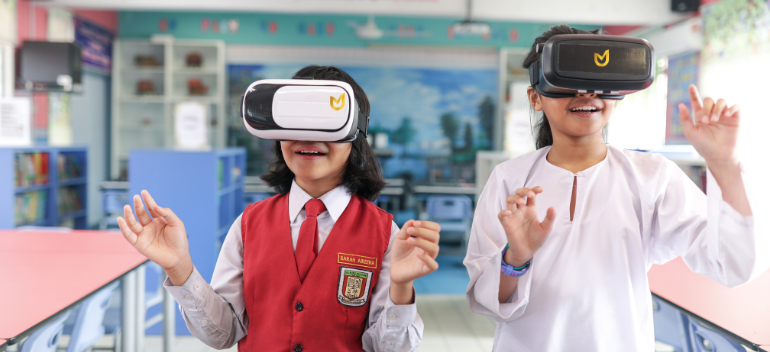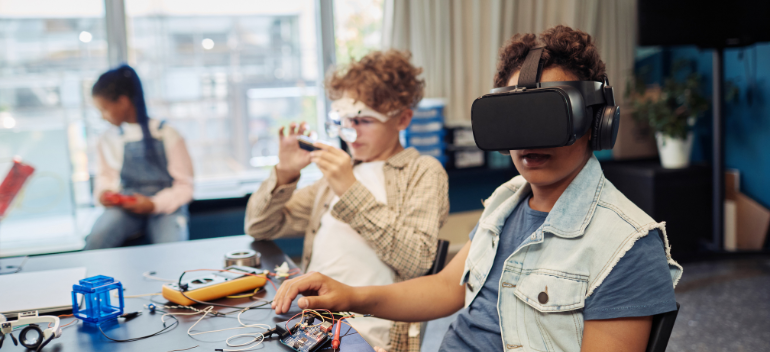
Exploring the Potential of Virtual Reality in Education
Virtual Reality (VR) is poised to revolutionize education by providing immersive learning experiences that engage students and enhance understanding. From virtual field trips to interactive simulations, VR offers a range of applications that can transform traditional education methods. This article explores the potential of VR in education, the benefits it offers, and the challenges that must be addressed to fully realize its potential.
VR as a Tool for Immersive Learning
Traditional classroom learning often relies on textbooks, lectures, and written assignments, which can be limiting for students who learn best through hands-on experiences. VR offers an alternative by creating immersive learning environments that engage multiple senses and promote active learning.
Virtual Field Trips: VR allows students to take virtual field trips to places they might never be able to visit in person, such as ancient historical sites, distant planets, or the depths of the ocean. These experiences can bring subjects like history, science, and geography to life, making learning more engaging and memorable.
Interactive Simulations: VR can also be used to create interactive simulations that allow students to practice skills in a virtual environment. For example, medical students can perform virtual surgeries, engineering students can build and test structures, and chemistry students can conduct experiments—all without the risks or costs associated with real-world practice.
Collaborative Learning in VR: VR enables students to collaborate in virtual environments, regardless of their physical location. Virtual classrooms, labs, and study groups allow students to work together on projects, share ideas, and learn from each other in a way that is not always possible in traditional settings.
Benefits of VR in Education
The use of VR in education offers several benefits that can enhance the learning experience and improve outcomes:
Increased Engagement and Motivation: VR’s immersive nature captures students’ attention and makes learning more enjoyable. When students are engaged and motivated, they are more likely to retain information and succeed academically.
Personalized Learning: VR allows for personalized learning experiences that cater to individual students’ needs, interests, and learning styles. For example, students can progress through lessons at their own pace, revisit difficult concepts, and explore topics that interest them in greater depth.
Safe and Controlled Learning Environments: VR provides a safe and controlled environment for learning complex or dangerous subjects. For example, students can safely practice procedures, explore hazardous environments, or conduct experiments that would be too risky or costly in the real world.
Challenges and Considerations
While VR offers exciting opportunities for education, there are also challenges that must be addressed:
Cost and Accessibility: The cost of VR equipment and software can be a barrier for many schools and institutions. Additionally, not all students may have access to the necessary technology at home, leading to potential disparities in learning opportunities.
Content Development: Developing high-quality VR educational content requires significant time, expertise, and resources. Educators and developers must work together to create content that is both educationally sound and engaging.
Teacher Training and Support: Integrating VR into the classroom requires teachers to be trained in using the technology effectively. This includes understanding how to incorporate VR into lesson plans, manage virtual environments, and assess student learning in a VR context.
Future Trends in VR Education
The future of VR in education is bright, with several trends set to drive further innovation:
AI-Powered Adaptive Learning: The integration of AI with VR will enable adaptive learning experiences that adjust to students’ progress and learning styles in real-time. This will create more personalized and effective learning experiences.
Global Classrooms and Cultural Exchange: VR will enable the creation of global classrooms where students from different countries can learn together and engage in cultural exchanges. This will promote cross-cultural understanding and collaboration.
VR in Lifelong Learning and Professional Development: VR will play a significant role in lifelong learning and professional development. From corporate training programs to continuing education for professionals, VR will provide immersive and practical learning experiences that enhance skills and knowledge.

Conclusion
Virtual Reality has the potential to transform education by providing immersive, engaging, and personalized learning experiences. While challenges such as cost, accessibility, and content development must be addressed, the benefits of VR in education are clear. As technology continues to advance, VR will play an increasingly important role in shaping the future of education, making learning more interactive, inclusive, and effective.




